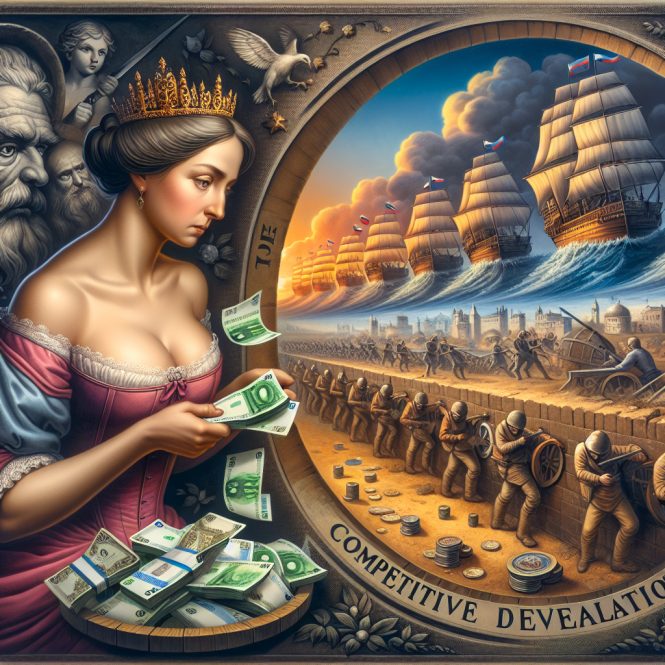
Competitive Devaluation and the Great Depression: A Theoretical Reassessment
Without further ado, let’s delve into the topic of “Competitive Devaluation and the Great Depression: A Theoretical Reassessment.” Few events in economic history have left as indelible a mark as the Great Depression of the 1930s. While numerous factors contributed to this global economic catastrophe, the role of competitive devaluation—a practice whereby nations deliberately weaken their currencies to gain short-term economic advantages—deserves a thorough reexamination. This essay aims to provide a theoretical reassessment of the relationship between competitive devaluation and the Great Depression, drawing on insights from ancient wisdom to modern economic theory.
The concept of currency manipulation is not new. As far back as 2000 BC, the Babylonian king Hammurabi recognized the importance of stable currency, declaring in his famous code: “If a merchant has given to an agent corn, wool, oil, or any sort of goods to traffic with, the agent shall write down the price and hand over to the merchant; the agent shall take a sealed receipt for the money he gives to the merchant.” This early understanding of the need for monetary stability starkly contrasts the chaotic currency policies that would emerge millennia later.
The Golden Straitjacket: From Stability to Chaos
The gold standard, which had provided stability to the global monetary system in the late 19th and early 20th centuries, began to unravel in the aftermath of World War I. Countries, burdened by war debts and seeking to regain economic competitiveness, started to abandon the gold standard one by one. This departure from a fixed exchange rate system opened the door to competitive devaluation strategies.
As the Roman philosopher Cicero astutely observed in the 1st century BC, “The sinews of war are infinite money.” In the context of the interwar period, this “infinite money” took the form of currency manipulation, as nations sought to gain economic advantages through monetary policy rather than military might.
British economist John Maynard Keynes, writing during the Great Depression, recognized the dangers of this approach. In his 1931 essay “The End of Laissez-Faire,” Keynes warned: “The decadent international but individualistic capitalism, in the hands of which we found ourselves after the war, is not a success. It is not intelligent, it is not beautiful, it is not just, it is not virtuous—and it doesn’t deliver the goods.”
The Domino Effect: Currency Wars and Economic Collapse
As nations engaged in competitive devaluation, a domino effect ensued. When one country devalued its currency, others felt compelled to follow suit to maintain their export competitiveness. This race to the bottom created a deflationary spiral that exacerbated the economic downturn.
The Chinese philosopher Lao Tzu’s ancient wisdom seems particularly relevant here: “The softest things in the world overcome the hardest things in the world.” In competitive devaluation, the “soft” manipulation of currency values proved more destructive than traditional “hard” economic policies.
The mass psychology of fear and uncertainty that gripped markets during this period amplified the adverse effects of competitive devaluation. As the 20th-century American economist Irving Fisher noted in his debt-deflation theory, falling prices increased the actual value of debts, leading to a wave of defaults and bankruptcies that further depressed economic activity.
Cognitive Biases and Policy Mistakes
Despite their destructive consequences, the persistence of competitive devaluation strategies can be partly attributed to various cognitive biases among policymakers and the public. The normalcy bias led many to believe that economic conditions would eventually return to pre-depression levels without significant intervention. The optimism bias caused leaders to underestimate the long-term negative impacts of their currency manipulations.
Furthermore, the framing effect allowed governments to present devaluation as a necessary evil for boosting exports and employment, obscuring the broader economic damage caused by these policies. As the 18th-century Scottish philosopher David Hume observed, “It’s not contrary to reason to prefer the destruction of the whole world to the scratching of my finger.” This insight into human nature helps explain how short-term national interests could override concerns for global economic stability.
The Austrian economist Friedrich Hayek, in his 1944 work “The Road to Serfdom,” warned against the dangers of centralized economic planning, including monetary manipulation. He argued that such interventions inevitably lead to unintended consequences and the erosion of financial freedom.
Contrarian Views: Reassessing the Role of Devaluation
While the negative impacts of competitive devaluation during the Great Depression are well-documented, some economists have proposed contrarian views that challenge the conventional narrative. For instance, Barry Eichengreen, in his book “Golden Fetters: The Gold Standard and the Great Depression, 1919-1939,” argues that countries that abandoned the gold standard earlier and devalued their currencies recovered more quickly from the Depression.
This perspective suggests that the problem was not devaluation itself but rather the uncoordinated and chaotic manner in which it occurred. As the ancient Greek philosopher Heraclitus noted, “The only constant in life is change.” Perhaps the failure to adapt monetary policies to changing economic realities contributed more to the Depression than the act of devaluation itself.
The Cantillon Effect: Winners and Losers in Currency Wars
The 18th-century French economist Richard Cantillon observed that changes in the money supply do not affect all economic actors equally or simultaneously. This insight, known as the Cantillon Effect, is particularly relevant to understanding the distributional consequences of competitive devaluation during the Great Depression.
As currencies were devalued, those closest to the source of new money – typically financial institutions and large corporations – benefited first. At the same time, ordinary citizens and small businesses bore the brunt of rising prices and economic instability. This uneven impact exacerbated social tensions and contributed to the rise of populist and extremist political movements in many countries.
Lessons for the Modern Era: The Specter of Currency Wars
The lessons of competitive devaluation during the Great Depression remain relevant in our modern globalized economy. As the 20th-century economist Milton Friedman warned, “Inflation is taxation without legislation.” In today’s world of fiat currencies and central banking, the temptation to use monetary policy as a tool for short-term economic gain persists.
The 2008 financial crisis and its aftermath saw renewed concerns about currency wars, with major economies accused of engaging in competitive devaluation through quantitative easing and other unconventional monetary policies. The Japanese economist Akinari Horii cautioned in 2013, “Currency wars are a manifestation of a deeper problem: the lack of a well-functioning international monetary system.”
Conclusion:
Competitive Devaluation and the Great Depression: A Theoretical Reassessment
As we reflect on the relationship between competitive devaluation and the Great Depression, it becomes clear that our current international monetary system remains vulnerable to similar destabilizing forces. The challenge for policymakers and economists in the 21st century is to design a system that promotes global economic stability while allowing for necessary adjustments in exchange rates.
Perhaps the solution lies in embracing the wisdom of the ancient Chinese strategist Sun Tzu, who advised, “The supreme art of war is to subdue the enemy without fighting.” This could mean developing cooperative frameworks for currency adjustment that prevent destructive competitive devaluations in international economics.
As we grapple with these complex issues, we would do well to heed the words of the 20th-century economist John Kenneth Galbraith: “The study of money, above all other fields in economics, is one in which complexity is used to disguise truth or to evade truth, not to reveal it.” Our reassessment of competitive devaluation and the Great Depression must cut through this complexity to reveal fundamental truths about the nature of money, power, and economic stability in an interconnected world.
In conclusion, the theoretical reassessment of competitive devaluation and its role in the Great Depression offers us historical insights and a roadmap for navigating the complex monetary challenges of our time. By understanding the psychological, economic, and social dynamics at play, we can build a more resilient and equitable global financial system that serves the interests of all nations and peoples rather than pitting them against each other in a race to the bottom.
Thought-Provoking Chronicles: Stories to Ponder
FAQ: Competitive Devaluation and the Great Depression: A Theoretical Reassessment
Q: What is the main argument presented in “Competitive Devaluation and the Great Depression: A Theoretical Reassessment”?
A: The study challenges conventional wisdom by suggesting that competitive devaluations during the 1930s may have actually helped hasten recovery from the Great Depression rather than worsening it. This reassessment contradicts historical accounts that have long accused currency devaluations of exacerbating the economic downturn.
Q: How does the theoretical model in “Competitive Devaluation and the Great Depression: A Theoretical Reassessment” differ from traditional views?
A: The research develops a two-country model of the gold-exchange standard, revealing that devaluation under a gold standard is not necessarily a beggar-thy-neighbour policy. This perspective offers a fresh theoretical framework for understanding the complex dynamics of currency manipulation during economic crises.
Q: Were competitive devaluations during the 1930s as widespread as commonly believed?
A: Recent research challenges the myth of widespread competitive devaluations in the 1930s. Analysis of exchange rate data and trade flows for 14 industrialized countries from 1929-1939 suggests that the impact of currency changes on foreign trade was not as straightforward as the conventional narrative implies. This finding adds nuance to our understanding of monetary policies during the Great Depression era.












